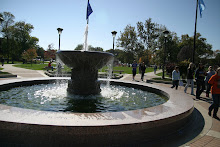by Bradley Levi
The exhibition on the anatomy of the Crucifixion took place on March 29 in the Hackelmeier Library Auditorium. Dr. Joseph Bergerson and Dr. Charles Dietzen came to campus to present information about the Crucifixion from a medical perspective.
Bergerson and Dietzen explained in their presentation the most obvious fact that Jesus died from crucifixion. However, they argued that the specific mechanism of how he died has been controversial among many physicians. The presenters
discussed how Jesus died, in light of current medical knowledge and historical importance of his crucifixion and controversial ideas about his death.
Bergerson and Dietzen have also indicated that many medical writers have suggested many possible reasons for Jesus’ death, including: fatal pulmonary embolism, rupture of the heart, suspension trauma, fatal stab wound, and shock.
Shock, according to Drs. Bergeron and Dietzen, is the most logical reason for the death of Jesus. They also explained
that there was a belief that Jesus’ early followers assumed that he returned again to the physical being after death by crucifixion on the third day.
The presentation included a scientific analysis and controversies of the Shroud of Turin, a medical examination of the Shroud of Turin, a full–sized model of the Cross, and a life-sized copy of the Shroud of Turin.
skip to main |
skip to sidebar

The Knight Times is a student newspaper dedicated to serving the Marian University student community. Our goal is to inform the Marian community on campus, local, and global issues. We strive to report the stories that matter and take student opinions and comments into consideration. We want you to read, comment, and enjoy!
Welcome to

- The Knight Times
- The Knight Times is a student newspaper dedicated to communicating campus, local, and global issues to the Marian University student community. We want you to read, comment and enjoy!
Photos Taken By:
Michael Schrader
David Leszcynski
Michael Schrader
David Leszcynski
Blog Archive
-
▼
2012
(28)
-
▼
April
(13)
- Student government elects new officers
- Marian goes global
- Cycling: a global sport
- German students meet Eva Kor, Holocaust survivor
- Anatomy of the crucifixion
- Biology students study in Puerto Rico
- Nursing students serve in Honduras
- Shoeless students stir debate
- Marian: Building Bridges, Med school
- First Show Choir initiated at Marian
- Bird watching tours in the EcoLab
- Speaking Center opens doors
- Simon Bruté Lecture 1st Annual Lecture
-
▼
April
(13)
Stay Tuned for our NEXT Issue...
February 24 2012